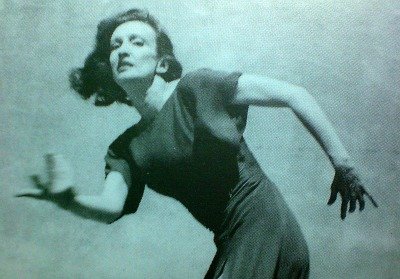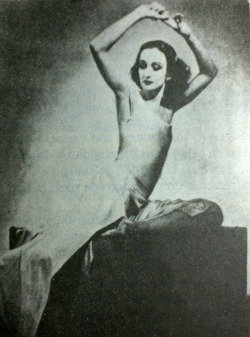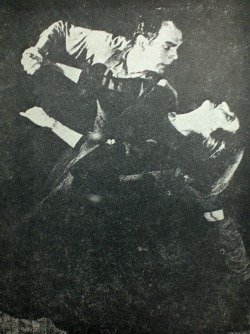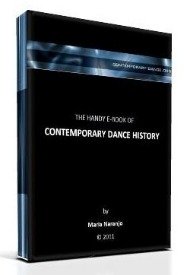DORIS HUMPHREY
Doris Humphrey (1895 – 1958 USA) is known in dance history for being a productive choreographer of the so called American modern dance trend. The creation of more than 100 choreographies between 1920 and 1957, together with a constant teaching activity, allow her to develop a gestural language, technical principles for dance and a system of ideas about choreography and its compositional method.
Among some of her most renowned contributions are:
-The introduction of the technical principle for dance called ‘fall and recovery’, which she founds in the observation of spontaneous behavior like walking, standing-lying down or being born-dying. (“Movement is situated on a tended arc between two deaths” is her most famous statement)
-The focus on dance composition for groups, which was somehow new for her time, as modern dance had been first a matter of soloists who developed an individual way of expression related to their bodies, emotions or personalities; but Doris Humphrey, with her reserved temperament, does not find her way through an egocentric form and works mainly with and for others (even though she dances herself until 1944).
- Experiments with the relationship between dance and music. She proclaims the option of dance’s autonomy towards music up to the possibility of dancing to the silence.
- Some steps towards one degree of abstraction, which can be read in statements like this one: “a group of bodies is an instrument as varied and colorful as an orchestra; it offers the composer a material that is as rich for accomplishing the totality of her/his vision. The group has also the impersonal and architectural attributes of the orchestra, which should be distinguished from the personal, expressive and unique qualities…” (Doris Humphrey quoted by Selma Jean Cohen. “Doris Humphrey, An Artist First”, Wesleyan University Press, Middletown, 1972.)
- The purpose of an innovative teaching method, in which she makes a difference between instruction and education; the first being a way of telling students what they have to do and the second being the development of their individuality and independence of thought, which is her aim.
-A book where she organizes a system for the study of choreography (dance composition), entitled “The art of making dances”. The following words can be read in her introduction to the manuscript: “…stating that we can not benefit from compositional techniques or that those can not be taught in dance, would be the equivalent of saying that the intellectual effort and analysis, even though they are valuable for all human activities, lack of sense or need for dance.”
 Doris Humphrey
Doris HumphreyYou will find more biographical details if you scroll down our page for modern dance history until the section about her.
Review of the book “THE ART OF MAKING DANCES” (1938) by DORIS HUMPHREY
If you are a choreographer, or have just had some experience trying to be one, you will very probably find a good amount of unspoken statements in this book that will feel familiar and comforting.
Though, this book is an exposition of the subjective position and insight of the author about how a choreographer should create choreography. By this, Doris Humphrey ’s book might contribute with some ideas and tools but a big part of its content stays at the level of a personal approach and lacks of objectivism as a working tool.
Humphrey proposes a theoretical frame that should serve as support for a compositional method. The tools that she exposes are constantly followed by examples, with recurrent judgments of value (of what is good and bad) that are always related to the aim of pleasing an audience (this is something that she explicitly accepts).
Some ideas for practical exercises are also provided, though I must say that without real examples, they are subjected to a wide interpretation by the reader.
If you don’t have time to read her whole book, have a look at the following summary. It will give you a general overview of the most important ideas she exposes:
INTRODUCTION
 Doris Humphrey in “Theater Piece”. Photo in “Danza moderna y contemporánea”. Marquez, G. Ed. Pueblo y Educación, La Habana, 1988.
Doris Humphrey in “Theater Piece”. Photo in “Danza moderna y contemporánea”. Marquez, G. Ed. Pueblo y Educación, La Habana, 1988.Doris Humphrey introduces “The ART of Making Dances” with an explanation of how dance is different in her time (1930s). She states that modern dance has awakened up to face reality in a new way (compared to romantic or classical ballet), using the metaphor of the sleeping beauty that wakes up and is ravenous and has other attributes to express (I guess this serves as a justification for the new approach she aims to propose).
After this, she makes a description of the choreographer’s profile. For her, the choreographer is a composer with a creative mind and has the following characteristics:
-Great observer.
-Has big curiosity for the bodies with which s/he works.
-Has a sense for drama (sense of dramatic structure and contrast).
-Has the sense of adjustment or coherence of the components of a piece.
-Has the sense of the verisimilitude (in opposition to the clichés or the sensational for itself and the tricks).
-Has a trained eye and ear as well as speed for judgment, taking decisions and finding means.
-Masters language and has something to say.
-"The choreographer is a fervent lover, full of enthusiasm for her/his new love: the next dance".
After describing her choreographer’s profile, she exposes what she considers to be the foundation of any dance: THE SUBJECT.
For Doris Humphrey, the subject is a basic idea from which dance emerges; it serves the choreographer as a source of motivation and gives life to the piece. Humphrey thinks that the subject is not necessarily found in a rational way, but can also arise from intuition.
Also, she believes that the value of a subject depends on the relationship with its context and gives a funny example to explain this. She ask herself why “The Dying Swan” was a piece of such a success and why a “Dying Dog” or something likewise hasn’t yet been created. So, she continues explaining that the value of a subject, in order to be successful among the audience, lies in its relationship with ‘the voice of its time’.
Though Doris Humphrey seems to be making steps towards a level of abstract choreography, because she differentiates between symbolism and pure movement in the text, she repeatedly defines the subject as a reference for representation and narrative communication of concrete contents.
After developing that idea with some examples and judgments of value, she concludes the chapter with a list of possible subjects for a dance, full of general and subjective opinions (of little use in my opinion).
THE TOOLS
The second part of Doris Humphrey ’s book exposes the conceptual tools that will serve as support to her compositional method.
Before starting to describe each on of the concepts, she exposes the following four main ideas:
-The four basic elements of danced movement are design, dynamic, rhythm and motivation.
-The choreographer should think in terms of movement more than in terms of steps.
- Composing starts by inventing movements as if they were ‘words’ that can be arranged like in verbal language (with syntax, grammar and so on).
- Using contrasts is of vital importance.
Design
• In space and from a visual point of view:
-Symmetric design in space expresses rest and asymmetric design expresses excitement. Each one of those can be composed with opposed movements (which express power) or successive movements (which express softness).
-Design in space should be created according to the intention of representing an idea.
• In time:
-Movement should be organized in phrases. Humphrey states that movement is more pleasant and understandable like this, as phrases create the dynamic of effort and rest, which is necessary to maintain the interest and avoid monotony.
-Time can also be understood in dramatic terms, other than just metrical terms. This means that an action lasts, for example, like what a spoken phrase lasts.
• In scenic space:
- The areas of the stage used will support or highlight different concepts or sensations. They will also deny them, so the choreographer should use judgment to choose them.
-The force of the areas of scenic space can be modified by lightning, sets and the dancer’s execution.
• For group:
-Each dancer, as an individual has dignity and importance (in contrast to dance in which there’s a soloist who shines and the group works just as an ornamentation).
-The work for group needs to have one chosen person who makes the decisions.
Dynamic
-Acute, soft, plain, fast, slow, tension, and rest are ways of naming dynamic variations, but are relative to the dancer execution.
-The dynamic is a tool to create contrasts and is necessary to avoid monotony.
Rhythm
- Rhythm is the most persuasive and powerful element of dance.
-It is found in the nature of human beings, through the patron of rise and fall or energy against gravity.
-The clue for the enjoyment of the audience is its understanding of the rhythmical organization of the dance.
-Other than metrical rhythm, there are also the emotional rhythm (dramatic rhythm) that should be verisimilar, and the rhythm of breath.
Motivation and gesture
-The choreographer should have a conscious motivation; movement needs to emerge from a purpose to avoid a technical, cold or mechanical representation. Motivation is what gives sense to the dancing technique.
- Dance should ‘say something’ as it is essentially a language to communicate; the dancer should act and live the emotions that s/he is representing.
-There are gestures that have established patterns and conventional meanings (social, functional, ritual and emotional) which serve as support for narrative communication.
OTHER TOOLS
Words
-Dance can also be complemented by talking but words must have a function and should add information. This is crucial for the meaning or otherwise they are unjustified.
Music
-Not all music is good for dancing. Melody, rhythm and dramatic quality are its closest characteristics to dance.
-Problems in the selection of the music for dance depend a lot of the economical conditions of the choreographer and the context in which s/he works.
-The use of music (musicality of dance) is something that has to be analyzed. Dance and music can be coherent in rhythm, dynamics and structure or not.
-There’s also the option of relying in the music’s structure as the dramatic structure for the dance.
-Dance can spare sound almost completely or even be performed in the silence.
Sets
-Sets are a mean for using vertical space or enriching the possibilities of movement. Props must have a justification, like a functional purpose in relation to movement, and should not be just an ornament.
-Props have a symbolic content on stage also.
Total form
-The total form of the dance (its dramatic structure) should imply a sense of continuity and rhythm in the development of the whole piece; there should not be death time during a show.
-Five common dramatic structures for dance are: ABA, narrative /tale form, theme and variations, suite, broken form (illogical, shapeless).
After explaining this series of tools from her personal point of view, Doris Humphrey makes a list of items that should serve to examine choreography, in order to make it successful and pleasant for the audience. They are accompanied with explanations and are presented as facts that she has confirmed through her years of composing and teaching:
-Symmetry lacks of life.
-Two-dimensional designs lacks of life.
-The eye is faster than the ear.
-Movement looks slower and weaker on stage.
-All dances are too long.
-A good end is 40% of the piece.
-Monotony is fatal; contrasts should be used.
-Don’t be a slave, nor a mutilator of music.
-Listen to the advice of those who know; don’t be arrogant.
-Don´t intellectualize, give motivation to movement.
-Don’t leave the end to the end.
CONCLUSION
At the end of the book, Doris Humphrey tries to expose the state of concert dance at her time. She definitely rejects abstract dance, to the point of calling it a sick art that is the consequence of a sick world and support this idea by saying that dance, as an art, definitely needs to be accepted by the audience to survive. As a consequence, she says, the choreographer is fatally tied to the need to communicate and the demands of her/his time (I believe I find unsolved contradictions like this one all through the book…).
Finally, she leaves a question opened: Which is the direction dance should take? For her, even though dance as an art, (which she says is modern dance, differentiating it from ethnic dances or social dancing) has awakened from its sleeping beauty state, it is at a current state of coma… (?)
So, she concludes saying that she hopes things will evolve positively for dance and that she will see its blossoming.
 Doris Humphrey and Charles Weidman in “Inquest”. Photo in “Historia de la danza”. Martin, J. Ed. Nal. de Cuba, La Habana, 1965.
Doris Humphrey and Charles Weidman in “Inquest”. Photo in “Historia de la danza”. Martin, J. Ed. Nal. de Cuba, La Habana, 1965.Though my point of view of Doris Humphrey ’s book points to her subjective commentaries as of little use, I believe that part of that content might very well serve for meditations about the relationship with the audience and the purpose of public success of a choreographic piece. If you are really into the study of choreography, I would say you better read the whole book yourself and make your own conclusions. I believe there is a lot of material in it that can serve as a starting point to issues and thoughts.
“I wish my dance reflects some of my personal experiences in relationship to the external world, that it is based on reality illuminated by imagination, that it is organic more than synthetic, that it causes an evident reaction in my audience and that it contributes to the drama of life.” Doris Humphrey
There’s an institution dedicated to maintain Doris Humphrey 's legacy, where you can look for further information. Find it through this link: Doris Humphrey Foundation UK.
Return from Doris Humphrey to Modern Dance History
Return to Contemporary Dance Home Page
The handy e-book of CONTEMPORARY DANCE HISTORY:
The Dance Thinker is our occasional E-zine. Fill in the form below to receive it for free and join us.
Read:
"The Dance Thinker"
BACK ISSUES
Post contemporary dance announcements (workshops, auditions, performances, meetings and important news... it is free.)




